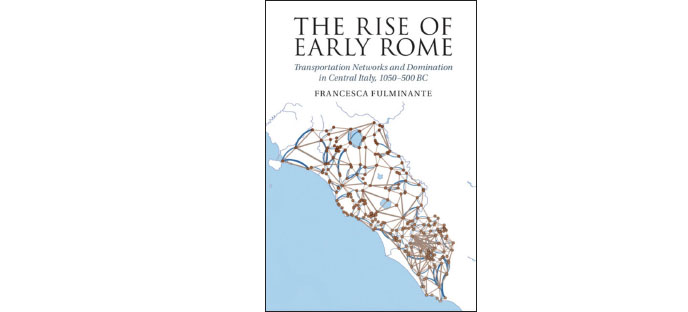Francesca Fulminante’s book ‘The Rise of Early Rome’ poses the following: Why did Rome and not Veii emerge as a centre of power and eventually the heart of an empire? To answer this question, Fulminante employs quantitative analyses and network approaches to compare the transportation (fluvial and terrestrial) systems of southern Etruria and Latium vetus.
Following the introduction, Chapter 1 revisits the debate on what constitutes an ‘ancient city’. Whilst this debate is not resolved here, Fulminante identifies recurring features shared across these settlements: the ability to generate greater division of labour, the construction of monumental buildings, and a common ideology and/or religious belief. In contrast to these traditional qualitative features, Fulminante argues for the use of network science as a framework for overcoming the difficulties in comparing different conceptual models. From here, Fulminante synthesises the urbanisation process in southern Etruria and Latium vetus from the Final Bronze Age to the Archaic Period (1175–500 BC). Chapter 2 is focused on the use of networks as both a heuristic tool and a formal method of quantification for understanding human interaction and urbanism in the Mediterranean specifically. Classic works in the use of network science in archaeology, including those by Fulminante, are summarised with this providing the necessary foundation for subsequent chapters.
Chapters 3 to 7 are devoted to the application of quantitative analyses and network approaches to understand differences in the transportation systems of southern Etruria and Latium Vetus. For Fulminante, transportation systems are a product of social cooperation between neighbouring polities and thus reflect the socio-political and economic system of a polity. Chapter 3 outlines the collation of data on settlements and transportation systems (terrestrial and fluvial). The rationale to divide settlement co-existence into seven time slices and the reconstruction of terrestrial and fluvial communication systems is reasonably justified. The methodological development from exploratory analyses to formal network modelling also offers a useful roadmap for future archaeological network studies. Chapters 4 and 5 apply a number of network centrality and efficiency measures to the reconstructed transportation system in central Italy. Fulminante shows that central places—settlements of significant size and socio-political and economic importance—in both Etruria and Latium Vetus were well connected within the terrestrial and fluvial transportation system. In particular, the development of settlements in Latium Vetus is strongly linked to the development of terrestrial routes. The efficiency measures similarly capture different results: fluvial routes in Latium Vetus are more efficient in exchanging information across the whole network, with the terrestrial routes also more resilient to perturbation. With the use of least-cost path analysis in Chapter 6, Fulminante models transportation routes at both the local and regional scale. The location of later Roman roads show similarity in their alignment to pre-existing local routes. This is corroborated by the calculated betweenness centrality—a proxy for the most used routes—for each site within Etruria and Latium Vetus. Fulminante argues that although sites were connected by local-scale routes, goods would have been moving across the Italian peninsula from the Bronze Age. Only later, with the establishment of state-imposed roads, did these local routes become a single named road at the peninsula-scale. This process of reusing local routes to form the long-distance routes of the Roman state is also replicated in later conquered provinces, e.g. Roman Britain. Finally in Chapter 7, Fulminante explores the mechanisms behind the creation and maintenance of the terrestrial infrastructure in Etruria and Latium Vetus. After an insightful summary on the principles of network modelling, three generative models representing different mechanisms are presented. Here, Fulminante shows that the infrastructure in Etruria aligns best with the model incorporating a level of ‘cooperation’ between settlements. Whilst the same model is initially consistent with the infrastructure in Latium vetus, the dominance of Rome leads to an unbalanced distribution of power—interpreted and subsequently modelled via the ‘the rich get richer’ mechanism.
Fulminante’s book is clearly structured and well-written, with the index an appropriate length. Typographical errors are minor, e.g. ‘least-coast path’ (p. 95). Figures are generally well presented but would have benefited from colour. The appendices are rich in detail and provide sufficient mathematical explanations and calculations for relevant chapters, although a summarised table of network measures and their qualitative interpretation would have been useful. Additional figures showing relevant settlements and reconstructed terrestrial routes for the various time slices would have also been welcome (p. 51).
Overall, Fulminante succeeds in demonstrating the efficacy of quantitative analyses and network approaches for answering the question: Why Rome and not Veii? With each subsequent chapter, Fulminante presents a new network analysis, moving from the descriptive to the generative. And yet throughout this, Fulminante never loses sight of the reasons behind why she chose network science: it is a tool that provides a consistent empirical framework to understand the past. This book offers a new perspective on the development of early Rome, as well as being a valuable contribution to those interested in applying network science to past transportation systems.
Joseph Lewis
Department of Archaeology
University of Cambridge
